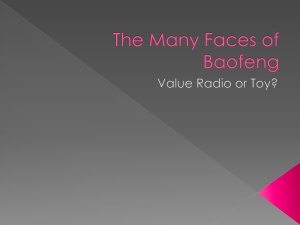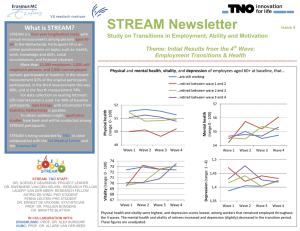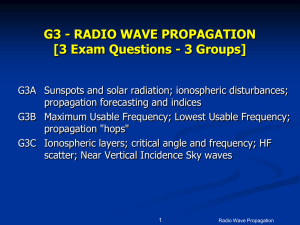Propagation
advertisement
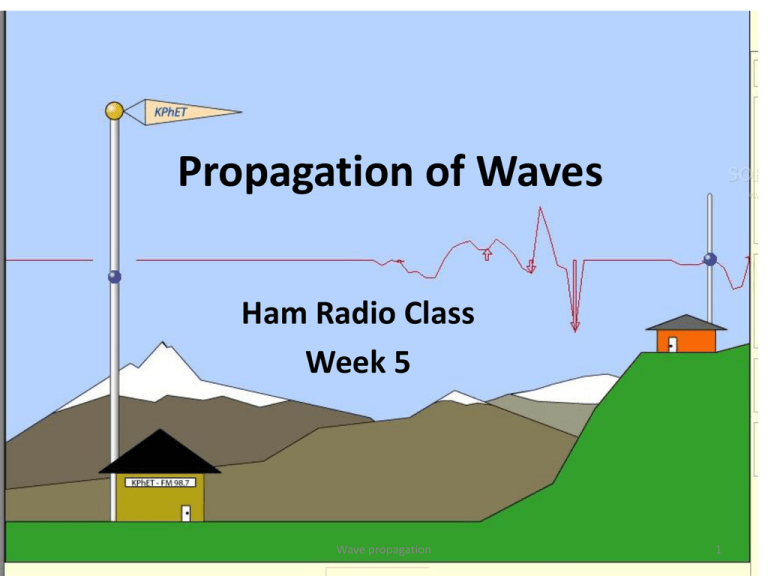
Propagation of Waves Ham Radio Class Week 5 Wave propagation 1 Propagation of waves Radio waves spread out from the antenna in straight lines (like light) Wave propagation 2 • The farther it travels the weaker it becomes, eventually becoming too weak to be received. The distance over which a transmission can be received is called range. Wave propagation 3 Possible routes of wave propagation The curvature of the earth sets a range limit for many signals; this is called a radio horizon. • The distance over which a transmission can be received is called range. The curvature of the earth sets a range limit for The distance over which a transmission can be received is called range. The curvature of the earth sets a range limit for many signals; this is called a radio horizon. (T3C10) many signals; this is called a radio horizon. (T3C10) Wave propagation 5 Communications at VHF and UHF are generally “line of sight” communications. That is they travel directly from the transmitting station to the receiving station. Wave propagation 6 Direct (not via a repeater) UHF and VHF signals are rarely heard from stations outside your local coverage area because these high frequency signals are not reflected by the ionosphere. Longer Radio waves can travel along the ground Wave propagation 8 Possible routes of wave propagation Radio waves can be reflected or refracted by sudden changes in the media through which they travel. Wave propagation 10 Obstructions can create radio shadows Knife-edge propagation is the term used to describe when signals are partially refracted around solid objects exhibiting sharp edges. Refraction also makes the earth seem less curved to VHF and UHF signals making them able to travel further that the line of sight. Wave propagation 12 Shorter waves lengths can more easily penetrate buildings, making communication from inside a structure more effective when using UHF signals. Wave propagation 13 Radio signals may take different paths from the transmitter to the receiver. This is called multipath. Wave propagation 14 Signals may interfere with each other if they are out of phase. Wave propagation 15 Problems/solutions with multipath propagation The irregular fading of signals from distant stations is caused by the random combining of signals arriving via different paths. Moving your antenna just a few feet may avoid the random reflections causing the multipath distortions. Wave propagation 16 Signals from mobile stations moving through an area with multipath have characteristic rapid variations in strength known as picket-fencing. Wave propagation 17 What should you do if another operator reports that your station’s signals were strong just a moment ago, but now they are weak or distorted? Move a few feet, as random reflections may be causing multipath distortions. Wave propagation 18 Why are UHF signals often more effective from inside buildings than VHF signals? The shorter wave length allows them to more easily penetrate the structure of the building. Wave propagation 19 What term is commonly used to describe the rapid fluttering sound heard from mobile stations that are moving while transmitting? Picket fencing Wave propagation 20 What is the cause of irregular fading of signals from distant stations during times of generally good reception? A.absorption of signals by the D layer of the ionosphere. B.absorption of signals by the E layer of the ionosphere. C.random combining of signals arriving via different path lengths D.distortion in the local receiver Wave propagation 21 What may occur if VHF or UHF data signals propagate over multiple paths? A. Transmission rates can be increased by a factor equal to the number of paths B. Transmission rates may decrease by a factor equal to the number of paths C. No significant changes will occur if the signals are transmitting using FM D. Error rates are likely to increase Wave propagation 22 What does the term knife-edge propagation mean? A. Signals are reflected back toward the originating station at acute angles B. Signals are sliced into several discrete beams and arrive via different paths C. Signals are partially refracted around solid objects exhibiting sharp edges D. Signals are propagated close to the band edge exhibiting a sharp cutoff Wave propagation 23 What is the radio horizon? A. The distance at which radio signals between two points are effectively blocked by the curvature of the Earth B. The distance from the ground to a horizontally mounted antenna C. The farthest point you can see when standing at the base of your antenna tower D. The shortest distance between two points on the Earth’s surface Wave propagation 24 Why do VHF and UHF radio signals usually travel somewhat farther than the visual line of sight distance between two stations? A. Radio signals move somewhat faster than the speed of light B. Radio waves are not blocked by dust particles C. The Earth seems less curved to radio waves than to light D. Radio waves are blocked by dust particles Wave propagation 25 Wave propagation can be assisted by atmospheric phenomena Wave propagation 26 Layers caused by temperature inversions form ducts that can carry signals much farther than typical line of sight communications Wave propagation 27 Layers with different properties refract waves with slight variations. This “tropospheric scattering often allows contacts over 300 miles. Wave propagation 28 The ionosphere is an area from 30 to 260 miles above the earth that has some unique electrical properties. Wave propagation 29 The ionosphere can completely reflect HF and VHF waves back toward the earth. (sky wave or skip) The earth’s surface can also reflect radios waves. (hop) Multiple reflections between the ionosphere/earth allows radio waves to be received around the world! Wave propagation 30 The ability of the ionosphere to refract waves depends on the frequency of the waves. Wave propagation 31 High frequency waves usually pass right through, this is why VHF and UHF signals are rarely heard beyond the radio horizon without being relayed by a repeater Wave propagation 32 As the sun illuminates the ionosphere the maximum usable frequency increases. This is why upper HF bands are more likely to by usable during the day. Wave propagation 33 During solar cycles patches of the ionosphere become sufficiently charged to reflect VHF and UHF signals back to Earth. This is called sporadic E propagation. Wave propagation 34 Sporadic E Propagation is most common during early summer and mid winter months on the 10, 6 and 2 meter bands. Wave propagation 35 Radio signals reflected off the aurora borealis exhibit rapid fluctuations and are often distorted. Wave propagation 36 It is possible to bounce radio signals of meteor trails. The best band for “meteor scatter” is the 6 meter band. Wave propagation 37 What mode is responsible for allowing overthe-horizon VHF and UHF communications to ranges of approximately 300 miles on a regular basis? A. Tropospheric scatter B. D layer refraction C. F2 layer refraction D. Faraday rotation Wave propagation 38 What band is best suited to communicating via meteor scatter? A. 10 meters B. 6 meters C. 2 meters D. 70 cm Wave propagation 39 What causes “tropospheric ducting”? A. Discharges of lightning during electrical storms B. Sunspots and solar flares C. Updrafts from hurricanes and tornadoes D. Temperature inversions in the atmosphere Wave propagation 40 What is generally the best time for longdistance 10 meter band propagation? A. During daylight hours B. During nighttime hours C. When there are coronal mass ejections D. Whenever the solar flux is low Wave propagation 41 Which part of the atmosphere enables the propagation of radio signals around the world? A. The stratosphere B. The troposphere C. The ionosphere D. The magnetosphere Wave propagation 42 Why are “direct” (not via a repeater) UHF signals rarely heard from stations outside your local coverage area? A. They are too weak to go very far B. FCC regulations prohibit them from going more than 50 miles C. UHF signals are usually not reflected by the ionosphere D. They collide with trees and shrubbery and fade out Wave propagation 43 Which of the following might be happening when VHF signals are being received from long distances? A. Signals are being reflected from outer space B. Signals are arriving by sub-surface ducting C. Signals are being reflected by lightning storms in your area D. Signals are being refracted from a sporadic E layer Wave propagation 44 What is a characteristic of VHF signals received via auroral reflection? A. Signals from distances of 10,000 or more miles are common B. The signals exhibit rapid fluctuations of strength and often sound distorted C. These types of signals occur only during winter nighttime hours D. These types of signals are generally strongest when your antenna is aimed to the south (for stations in the Northern Hemisphere Wave propagation 45 Which of the following propagation types is most commonly associated with occasional strong over-thehorizon signals on the 10, 6, and 2 meter bands? A. Backscatter B. Sporadic E C. D layer absorption D. Gray-line propagation Wave propagation 46
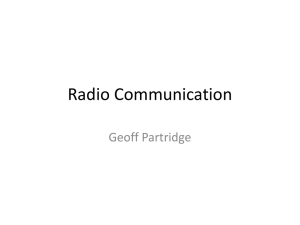
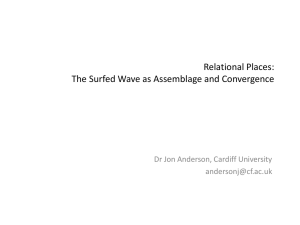

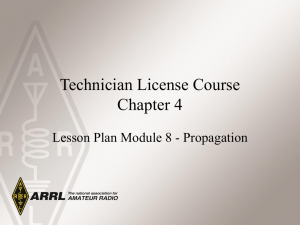
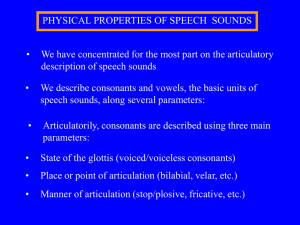
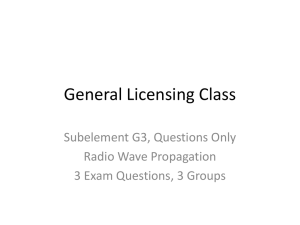
![Kaikoura Human Modification[1]](http://s2.studylib.net/store/data/005232493_1-613091dcc30a5e58ce2aac6bd3fb75dd-300x300.png)


